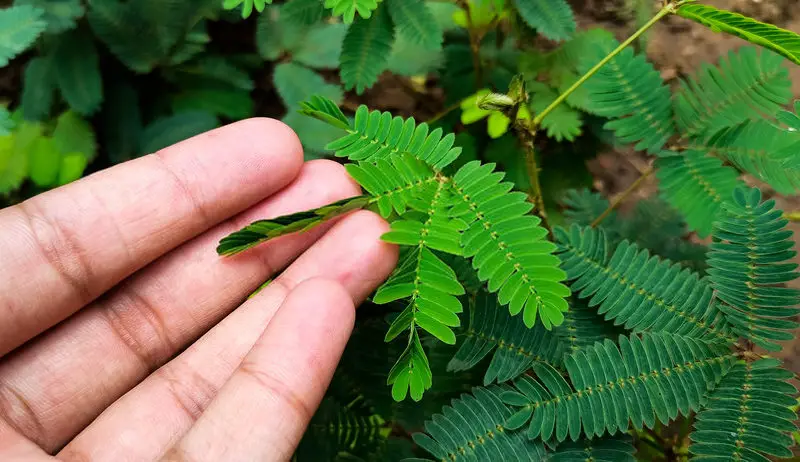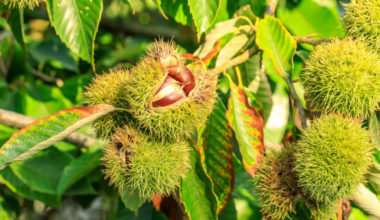The sensitive plant, or Mimosa pudica, is a delightful ephemeral perennial, often considered an annual in our climates. From the leguminous family, it is related to the Acacia genus which includes our popular mimosas with deliciously scented golden yellow pompons.
Native to the tropical zones of South America where its bushy habit can extend up to 2 to 3 ft, it is only grown in pots in our temperate regions and then hardly exceeds 3 ft.
Its pronounced taste for humid atmospheres predestines it to be grown in a terrarium or in a heated mini-greenhouse, but it will do well in a veranda or a bright interior where the temperature never drops below 59°F, and provided that the air is not too dry!
Contents
Mimosa pudica, the plant that responds to touch
Who hasn’t come across this strange plant in a garden center that closes its foliage as soon as it is touched? It is the well named “sensitive”, from its Latin name Mimosa pudica. Native to the tropical areas of South America, this rather peculiar perennial plant is part of the Fabaceae (or Leguminosae) family.
In culture, the sensitive rarely exceeds 75 inches in height, while in nature it can reach 6 ft. Bushy, even carpeting, it covers vast areas in its natural environment. Its foliage, very cut, has the capacity to protect itself from predators by folding on itself at the slightest contact, making the plant appear unappetizing.
The same phenomenon will be induced by rain or nightfall (as on the albizia for example). At the end of the summer, Mimosa pudica is adorned with small round inflorescences (1 inch in diameter) composed of bristly stamens of lilac blue or pink color.
How to grow the sensitive plant indoors?
Of tropical origin, the Mimosa pudica can only be grown indoors. It does not support the cold and the too dry air. It will thus be necessary to recreate its natural environment by keeping it warm (minimum 59°F) and by maintaining a good hygrometry.
Furthermore, it is possible to sow the sensitive in spring when the temperatures will have reached at least between 64 and 77°F. When the seedlings reach two leaves, you can transplant them in a pot.
For the plantation, install your plant in a mixture a little acid containing 1/3 of compost, 1/3 of soil of heather and 1/3 of peat. The pot must be pierced at the bottom and contain clay balls or gravel for drainage. The plant should be displayed in a very bright place, but without direct sunlight that could burn its foliage during the hottest hours of the day.
How to maintain the plant which responds to the touch?
The sensitive needs humidity, it is thus necessary to take care to water it regularly especially in summer. The soil should always be slightly humid and fresh. In winter, watering will be strongly reduced. To avoid the appearance of red spiders, do not hesitate to spray its foliage when it is very hot. In spring, during the growth period, bring liquid fertilizer every 15 days.
To keep the plant healthy, you should not try to touch it all the time and have fun opening and closing its foliage. The more one practises this gesture and the more the plant is exhausted.
Attacks and diseases of the sensitive
These sensitive plants are not sensitive to the diseases. In a too dry atmosphere, their leaves can wilt and they can undergo attacks of red spiders spotted with fine webs between the leaves. Remember to regularly spray the foliage of your sensitive as a preventive measure.
Also beware of excess moisture in the substrate which can lead to root rot.
3 other plants that respond to touch
Dionaea muscipula
Its strangeness and specificities make the dionaea a sure value in terms of originality for many years. Easy to find in garden centers, the beautiful carnivorous plant native to North America (North and South Carolina) is nowadays available in multiple cultivars. Growing spontaneously in sphagnum swampy areas or peat bogs, Dionaea muscipula otherwise called “flycatcher” or “wolfbane” is a very particular herbaceous perennial plant.
The plant is presented in the form of a rosette carrying winged petioles provided in their extremities of two articulated lobes similar to a jaw provided with flexible spines appearing as teeth. The internal face often colored of red of these two lobes presents sensitive cilia triggering the closing of the trap on the imprudent insect.
Drosera rotundifolia
Drosera (Drosera rotundifolia) is a well known carnivorous insectivorous perennial plant also called Rossolis, Sundew, Dew grass or Fly killer. It is found in the bogs of temperate Europe, boreal Asia and North America.
Its leaves with orbicular limb, in the shape of spoon, are laid out in rosette by 6 to 10, spread on the ground, and they carry on their higher face and their edges, red glandular hairs with long pedicel. These serve to capture the insects which are engulfed as on flypaper: the leaf closes by imprisoning its prey which will be digested by the enzymes produced. Once the insect is digested, the trap reopens.
Utricularia
The bladderworts are likely to disappoint amateur botanists attracted by the curiosity of seeing, during an excursion in natural environment, a carnivorous plant in full action, “swallowing” its victim. The trap in question, the utricle, rarely reaches a diameter of more than 0.1 inch, and often captures only microscopic prey.
Moreover, they act under water and, finally, the capture is very fast, performed in about 1/460th of a second, making its observation absolutely impossible without very special techniques. It is rather the knowledge of this very refined method of capture which arouses the interest that one must carry to him.









